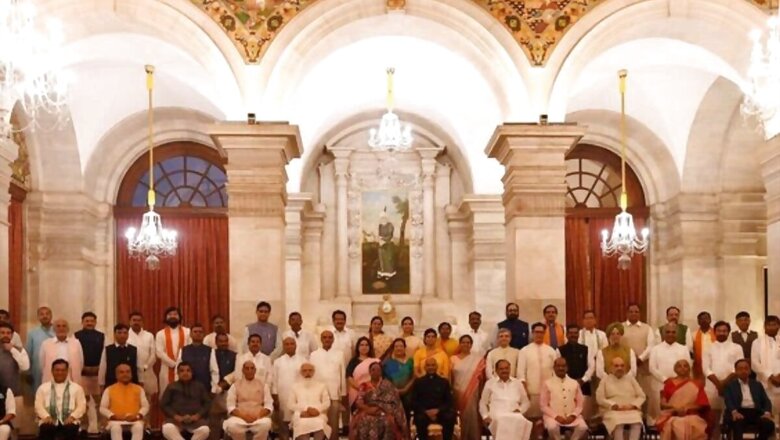
views
नियतं कुरु कर्म त्वं कर्म ज्यायो ह्यकर्मण: |
(Constantly perform your duties as action is superior to inaction)
तस्मादसक्त: सततं कार्यं कर्म समाचर |
(Therefore, giving up attachment, perform actions as a matter of duty)
Portions of Verses 8 and 19 from Chapter 3 of the Bhagavad Gita reflect the decisions made by Prime Minister Narendra Modi in the choice of his New Team. 26 months into the formation of a government under his leadership for the second time, there is a major overhaul of the Council of Ministers. It has been an eventful period with the pandemic pushing every arm of the government to the edge. The most critical test was of those directly involved with social welfare, information and justice. And it is in these departments that there have been massive shake-outs.
Many would see this as an admission of failure on part of the Prime Minister but it is fair to see it from the prism of learning, course correction and making the necessary adjustments towards reaching that lofty goal that the PM himself has set. The goal of an Atmanirbhar Bharat. A 17-letter idiom that weighs on the 17th Lok Sabha especially, the 77 members of the Government heavily. It is a tall ask to set the nation on course to self-reliance and show significant progress in the next 2.5 years. Even the strongest detractors of the Prime Minister will agree that he is a workaholic. He sets the highest standards of effort and expects the same from his team. Earlier, before PM Modi led NDA to power in 2014, the perennial crib would be that there are many hands pulling the cart but the cart is going nowhere. Now his detractors question the direction in which the cart is being pulled or the manner in which the course set is being traversed. More than the idea it is the implementation that is subject to intense scrutiny. This is a welcome shift.
But therein also lies the challenge for the PM. Implementation is key. Delivery of promises made is the only report card which the PM wants to take back to the people. Atmanirbhar Bharat is the vision, Sabka Saath Sabka Vikas Sabka Vishwas the goal while Antyodaya is the means to achieving it. If the life of the person at the lowest rung of society in the farthest corner of the country is improved/transformed then the vision of Atmanirbhar Bharat can be fulfilled.
This team of 77 has been tasked with accelerating the pace of implementation. And they have been handpicked from across India. 25 states and Union Territories get a representation including 5 from the Northeast, a never-before. For 7 decades Tripura has never had a representation at the Centre. This is the first time and Rajkumar Ranjan Singh is now part of the MEA.
A quick glance at the state-wide representation of the 43 new inductees reflects the pan-India presence and electoral considerations given to the 7 state assembly polls in 2022.
Uttar Pradesh: 7
Anupriya Patel
BL Verma
SP Singh Baghel
Kaushal Kishore
Pankaj Choudhary
Bhanu Pratap Verma
Ajay Kumar
West Bengal: 4
Subhas Sarkar
Shantanu Thakur
John Barla
Nisith Pramanik
Karnataka: 4
Rajeev Chandrasekhar
Shobha Karandlaje
A Narayanaswamy
Bhagwanth Khuba
Maharashtra: 4
Narayan Rane
Kapil Moreshwar Patil
Dr Bhagwat K Karad
Dr Bharati Pravin Pawar
Gujarat: 3
Darshana Jardosh
Devusinh Chauhan
Dr Munjapara Mahendrabhai
Northeast: 3
Sarbananda Sonowal: Assam
Pratima Bhoumik: Tripura
Rajkumar Ranjan Singh: Manipur
Madhya Pradesh: 2
Dr Virendra Kumar
Jyotiraditya Scindia
Bihar: 2
RCP Singh: JD(U)
Pashupati Kumar Paras: LJP
Odisha: 2
Ashwini Vaishnaw
Bishweswar Tudu
Uttarakhand: 1
Ajay Bhatt
Rajasthan: 1
Bhupender Yadav
Jharkhand: 1
Annapurna Devi
Tamil Nadu: 1
L Murugan
Delhi: 1
Meenakshi Lekhi
Allies have been accommodated despite the BJP having enough in its rank and file of MPs. What is heartening is the number of professionals who find a significant place in the Council of Ministers. There are 31 Lawyers, Doctors, Civil Servants. There are 4 former Chief Ministers in the mix and 23 who have been MPs at least thrice. Despite this, at 56 years, the average age of the cabinet is the youngest ever. There has been an addition of 25 new faces while 12 have been dropped. Significant addition of muscle, yet compared to governments in the past, at 77 this Council of Ministers is still leaner. It is, though, the 3rd largest since 1990. On caste and community lines also this is the first time that SC, ST and OBCs find such a high representation. 47 of the 77 in PM Modi’s Council of Ministers are from these social groups. There are 11 women ministers of which 2 have cabinet rank. Below is a quick overview:
The new-look Team Modi
- From SC Community
12 2
In Council With Cabinet Rank
- From ST Community
8 3
In Council With Cabinet Rank
- From OBC Community
27 5
In Council With Cabinet Rank
- Women Ministers
11 2
In Council With Cabinet Rank
- Ministers Below Age Of 50
14 6
In Council With Cabinet Rank
Interestingly Covid 19 has also helped in some key learning. 30 cabinet ministers and 47 Ministers of State (2 with Independent charge) will helm 53 ministries. Some ministries have been clubbed to ensure greater coordination and delivery. Many have welcomed Skill Development being clubbed with Education under Dharmendra Pradhan while Health, Chemicals and Fertilisers being clubbed under Mansukh Mandaviya is the result of pandemic learning. Culture, Tourism and Northeast being clubbed under the now-promoted G Kishen Reddy is also significant. It is a huge ask from the Telangana leader but if he gets it right this move will also pay rich dividends.
Mansukh Mandaviya
(Health, Chemical & Fertilizers)
Pharmaceuticals & chemicals essential for drugs key to medical infrastructure
Dharmendra Pradhan
(Education, Skill Development & Entrepreneurship)
Right balance between syllabus & skillsets need of the hour when job creation is a big challenge
RK Singh
(Power, New and Renewable Energy)
Will help India move from fossil fuel dependence to clean & green energy
G Kishan Reddy
(Culture, Tourism and Northeast)
Will help put serene, relatively unexplored N-E on India’s tourism map
Piyush Goyal
(Commerce and Industry, Consumer Affairs & Textiles)
More convergence in policymaking, help to boost earnings & exports for India-made textile
Piyush Goyal has been instrumental in streamlining the Railways which now will be taken forward by Ashwini Vaishnaw. Piyush ji has been tasked with India’s export challenge and in making Bharat the textile hub. Clubbing Commerce, Industry and Textiles under him will be crucial towards improving India’s Balance of Trade and also energising the private sector who are vital towards job creation and fuelling demand. Many ministers have taken charge of Day 1 itself. The team is in work mode already with the first cabinet and council of ministers meeting held inside of 24 hours of the leaders swearing in. The message from the PM is clear. Don’t celebrate ministership. Work hard and celebrate the chance to serve the people. The entire council has been advised that unless it is otherwise absolutely imperative, they stay put in Delhi and work in their ministries till August 15. Some major decisions were announced soon after the 1st meeting of the new cabinet.
Big decisions on Day 1
- Rs 23,123 crore package to boost emergency health infrastructure
- 20,000 ICU beds also under the Covid relief package
- Paediatric care centres will be formed in as many as 736 districts
- Rs 1 lakh crore fund for farmers under APMC
- Efforts will be made to provide more resources to the APMCs
- Reconstitution of the Coconut Board
Last but not least is perhaps the most significant development which so far seems to have slid under the radar. Many are still grappling with the idea behind and impact of the creation of the Cooperation Ministry. This was a promise made in the budget but along with that Cooperatives are a vital cog in the Antyodaya plan. The importance accorded to this move is reflected in the fact that the responsibility falls on the shoulders of the 2nd most powerful man in government today, Home Minister Amit Shah. He has been closely involved in setting right and propping up the cooperative movement in Gujarat. He personally ensured those that suffered during the Madhavpura Mercantile Cooperative Scam got their money back. Those close to Amit Shah say that he refused to shave till he had ensured the investors got their deposits back. He was closely involved with the functioning and operation of various co-operatives and ensured the entire cooperative mechanism was robust. Fraudsters across party lines were dealt with an iron hand. Many may contend that Co-operatives under Article 7 is a state subject. But like with the Farm Laws, pan-India and multi-state co-operative mechanisms will need centralised regulation. The potential of this ministry is huge. Another aspect before signing off. The New Team has the imprint of a line of succession. The selection of the team hints at the captain of the future is the NDA under PM Modi were to come back strongly in 2024. If you look closely, the question ‘who after PM Modi’ is also answered in the choice of this Council. The foundations have been laid. The team has been chosen. The vice-captain or captain-in-waiting is also decided. Now, to hit the ground running.
Read all the Latest News, Breaking News and Coronavirus News here.














Comments
0 comment